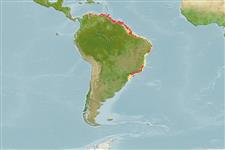Environment: milieu / climate zone / depth range / distribution range
Écologie
marin; saumâtre; profondeur 5 - 36 m. Tropical; 12°N - 30°S, 89°W - 32°W (Ref. 188)
Western Atlantic: Panama, Trinidad, and the Guianas southward to southern Brazil.
Taille / Poids / Âge
Maturity: Lm ? range ? - ? cm
Max length : 18.0 cm TL mâle / non sexé; (Ref. 5217); common length : 12.0 cm TL mâle / non sexé; (Ref. 5217); poids max. publié: 33.00 g (Ref. 118626)
Épines dorsales (Total): 0; Rayons mous dorsaux (Total): 0; Épines anales 0; Rayons mous anaux: 36 - 42. Belly with 17 to 20 + 5 to 7, total 22 to 26 scutes. Eye large, lower jaw projecting; upper jaw with a toothed hypo-maxillary bone between hind tip of pre-maxilla and lower bulge of maxilla blade. Pelvic fins with distinct axillary scale; anal fin long, its origin under middle of dorsal fin base. Scales easily lost (Ref. 188). Bluish gray above, sides silvery (Ref. 37032).
Found inshore, along beaches and down to at least 16 m over a muddy bottom. Enters estuaries, but perhaps not tolerating very low salinities (Ref. 12225).
Life cycle and mating behavior
Maturité | Reproduction | Frai | Œufs | Fécondité | Larves
Whitehead, P.J.P., 1985. FAO Species Catalogue. Vol. 7. Clupeoid fishes of the world (suborder Clupeoidei). An annotated and illustrated catalogue of the herrings, sardines, pilchards, sprats, shads, anchovies and wolf-herrings. FAO Fish. Synop. 125(7/1):1-303. Rome: FAO. (Ref. 188)
Statut dans la liste rouge de l'IUCN (Ref. 130435)
Menace pour l'homme
Harmless
Utilisations par l'homme
Pêcheries: pêcheries vivrières
Plus d'informations
Noms communsSynonymesMétabolismePrédateursÉcotoxicologieReproductionMaturitéFraiRassemblement de ponteFéconditéŒufsDéveloppement de l'œuf
RéférencesAquacultureProfil d'aquacultureSouchesGénétiqueElectrophoresesHéritabilitéPathologiesTraitementNutrientsMass conversion
CollaborateursImagesStamps, Coins Misc.SonsCiguateraVitesseType de nageSurface branchialeOtolithesCerveauxVision
Outils
Articles particuliers
Télécharger en XML
Sources Internet
Estimates based on models
Preferred temperature (Ref.
123201): 24.8 - 27.9, mean 27.3 °C (based on 82 cells).
Phylogenetic diversity index (Ref.
82804): PD
50 = 0.5156 [Uniqueness, from 0.5 = low to 2.0 = high].
Bayesian length-weight: a=0.00794 (0.00662 - 0.00954), b=3.02 (2.97 - 3.07), in cm total length, based on LWR estimates for this species (Ref.
93245).
Niveau trophique (Ref.
69278): 4.2 ±0.73 se; based on food items.
Résilience (Ref.
120179): Haut, temps minimum de doublement de population inférieur à 15 mois (Preliminary K or Fecundity.).
Fishing Vulnerability (Ref.
59153): Low vulnerability (10 of 100).
Nutrients (Ref.
124155): Calcium = 227 [115, 485] mg/100g; Iron = 1.88 [1.11, 3.12] mg/100g; Protein = 19.5 [18.0, 20.8] %; Omega3 = 0.456 [0.222, 0.877] g/100g; Selenium = 33.1 [16.2, 68.4] μg/100g; VitaminA = 38.6 [14.0, 101.2] μg/100g; Zinc = 1.55 [1.05, 2.21] mg/100g (wet weight);
